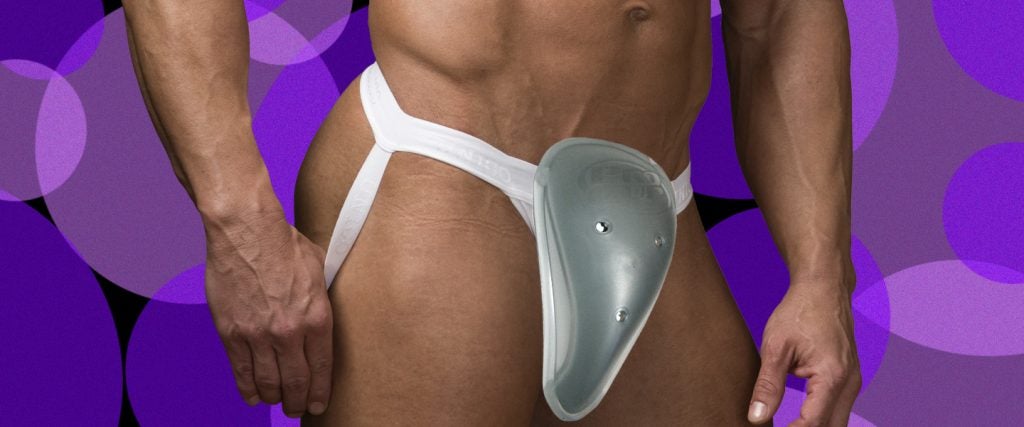April is Testicular Cancer Awareness Month, and we’re grabbing it right by the balls. Every day for the entire month, we will be publishing a new story aimed at getting men to better consider — and cherish — their family jewels in hopes of helping prevent a diagnosis that, if caught early enough, shouldn’t prove fatal. Read everything here.
Back in 2018, St. Louis Cardinals catcher Yadier Molina encountered a nightmare scenario: In the blink of an eye, a 102 mile-per-hour fastball tipped off a bat and flew straight into his groin, leaving Molina badly hurt. He was rushed to an emergency room for surgery on a hematoma, and needed a month off in order to recuperate.
He was reportedly wearing a cup when he got nailed in the sack, but it clearly didn’t do any good, shattering or otherwise failing to maintain integrity under the sheer force of the tipped pitch. And he isn’t alone in suffering injury due to a busted cup: Orioles catcher Caleb Joseph needed emergency surgery to fix his right testicle after his cup cracked from being smacked by a tipped ball in 2016.
These high-profile incidents, while painful to the point of tragic, also served as a golden opportunity for protective cup brands shilling cutting-edge alternatives. In the aftermath of his injury, Molina and the Cardinals received pitches from NuttyBuddy, Diamond MMA and Nutshellz to become their official cup provider. Ultimately, the team went with Nutshellz, which touts the use of Kevlar and carbon fiber for a light and literally bulletproof cup that cannot shatter like conventional versions.
The protective cup has its origins in the birth of the jockstrap, which arrived in 1874 as a way for bicycle jockeys to support and protect their balls while riding on the rocky cobblestone paths of Boston. Thirty years later, journeyman baseball catcher Claude Berry became the first man to introduce a steel protective cup to the major leagues.
But despite nearly 120 years passing since its debut in 1904, the cup really hasn’t evolved that much. Historically, athletic cups were made of perforated steel; now, the vast majority are made with tough plastic. Beyond that and some tweaks to the shaping of the cup, the methodology remains more or less the same. Their efficacy is still dependent on precise sizing, and they still require an undergarment for support, whether it’s a jockstrap or, more popular these days, compression shorts.
Nobody’s been able to dream of a better way to save a ballsack from the agonizing pain of direct impact. Have we truly reached the zenith of the protective cup?
It’s possible that we have, especially when you consider that more and more pro athletes have given up wearing a protective cup over the years, whether it’s football, baseball, basketball or soccer. It’s not that we’ve become more impervious to nut shots; urologists continue to urge athletes, especially young kids, to wear one and prevent nasty, potentially long-lasting injuries like testicular rupture or torsion. But the belief that cups are bothersome, uncomfortable and/or rob performance is one that remains pervasive in all kinds of sports leagues, despite the promises from new-school brands developed in the last decade. One damning statistic: Fewer than 13 percent of 700 high school and college athletes surveyed for a 2015 study said they wear a cup for protection.
“I don’t know if there’s invincibility, but it’s painfully clear that today’s millennial generation approaches wearing a protective cup differently than past generations,” Joel Sumfest, lead author of the study, told the Williamsport Sun Gazette.
That doesn’t mean those new brands aren’t trying their damndest to sell the gospel of comfy, state-of-the-art ball protection, especially with more conventional cups from UnderArmor being recalled for shattering on impact back in 2009. NuttyBuddy founder Mark Littell is famous for his stunts demonstrating how his cup can withstand, among other things, direct fastballs from a pitching machine flawlessly. Diamond MMA founder Craig Diamond, meanwhile, has racked up views on TikTok, especially with a video of a young kid swinging a metal bat directly into his groin, to seemingly zero effect.
Not one to be outdone, Jeremiah Raber, the madman founder of Nutshellz, took a shot in the nuts from a 9mm rifle while wearing one of his own cups. It’s a feat that serves as evidence of the theory that we’re at peak protective cup capabilities in 2022, unless someone can design a miniature force field for the groin using quantum physics. And perhaps what comes next is just a decline and a plateau — nobody entering sports seems all that convinced they need any kind of additional protection around their family jewels, even if there’s always a chance of a terrible blow.
Some 14 years ago, Popular Science asked what the future of the cup could be, beyond just stronger, more comfortable versions of the age-old hard-shield design. “Consider this a challenge to every engineer, designer and frat boy to do more for that which means so much to us all … to design the inflatable gel system with a hydraulic pump and impact sensors,” the article proclaimed.
There is no such novelty cup being developed, even after all this time. Turns out, protecting your balls is a fundamental task with a simple methodology — and there’s apparently no need for a cup revolution beyond Kevlar and carbon fiber.

